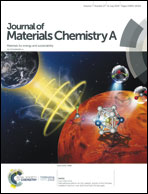Simple and scalable synthesis of CuS as an ultrafast and long-cycling anode for sodium ion batteries†
Abstract
During the development of sodium ion batteries (SIBs), a long cycle life, high capacity, and high rate are required for the anode materials. In this study, CuS is synthesized by heating S on a Cu current collector at 80 °C for 5 h, which is a simple and scalable process. The CuS exhibits excellent cycle stability of 517 mA h g−1 at 5 A g−1 after 2000 cycles, with 99.2% retention and a coulombic efficiency of almost 100%. CuS also exhibits an ultrahigh rate capability up to 100 A g−1 with a 268 mA h g−1. The CuS electrode is suitable for mass production and displays excellent electrochemical performance; therefore, it is a promising anode for SIBs. Moreover, ex situ scanning electron microscopes are applied to investigate their structural changes. During cycling, the shape of the electrode changes to multiundulating, and then to a flat plate covered with nanometer-sized particles, which can be induced by cracking, pulverization, and agglomeration. Through agglomeration, the CuS recovers from the electric isolation caused by pulverization. This self-healing characteristic could represent a new way of obtaining a long cycle life for anodes with volume changes.



 Please wait while we load your content...
Please wait while we load your content...